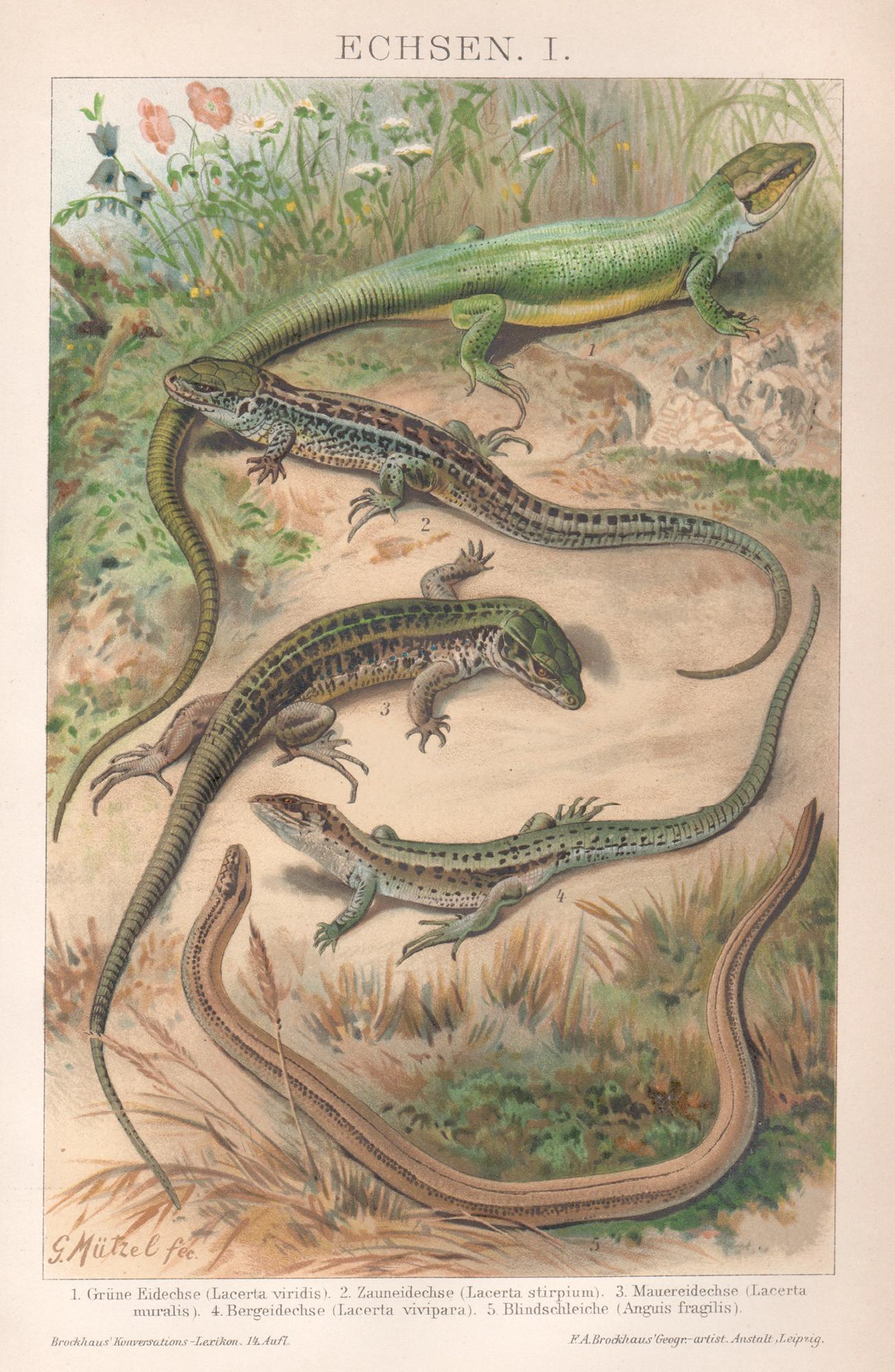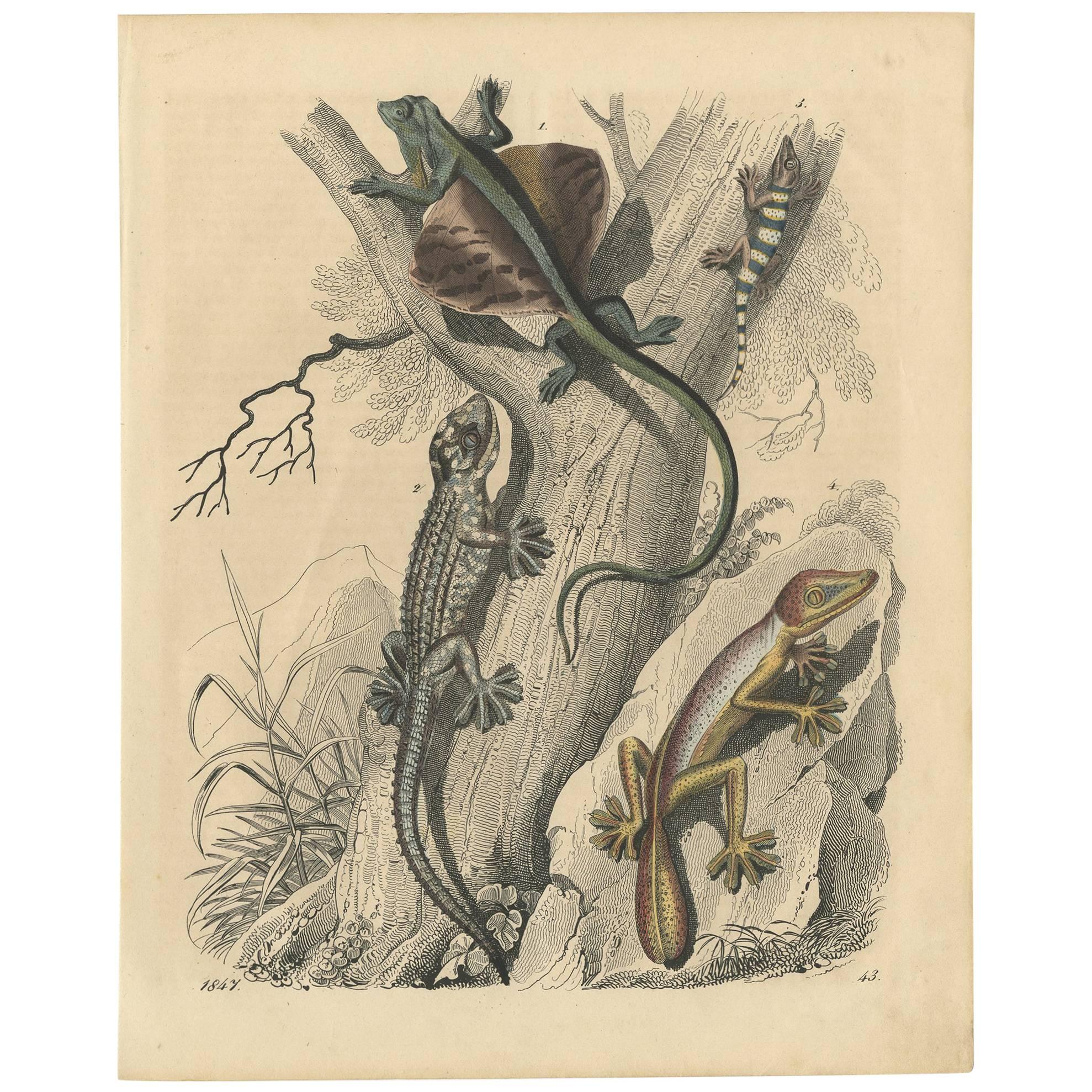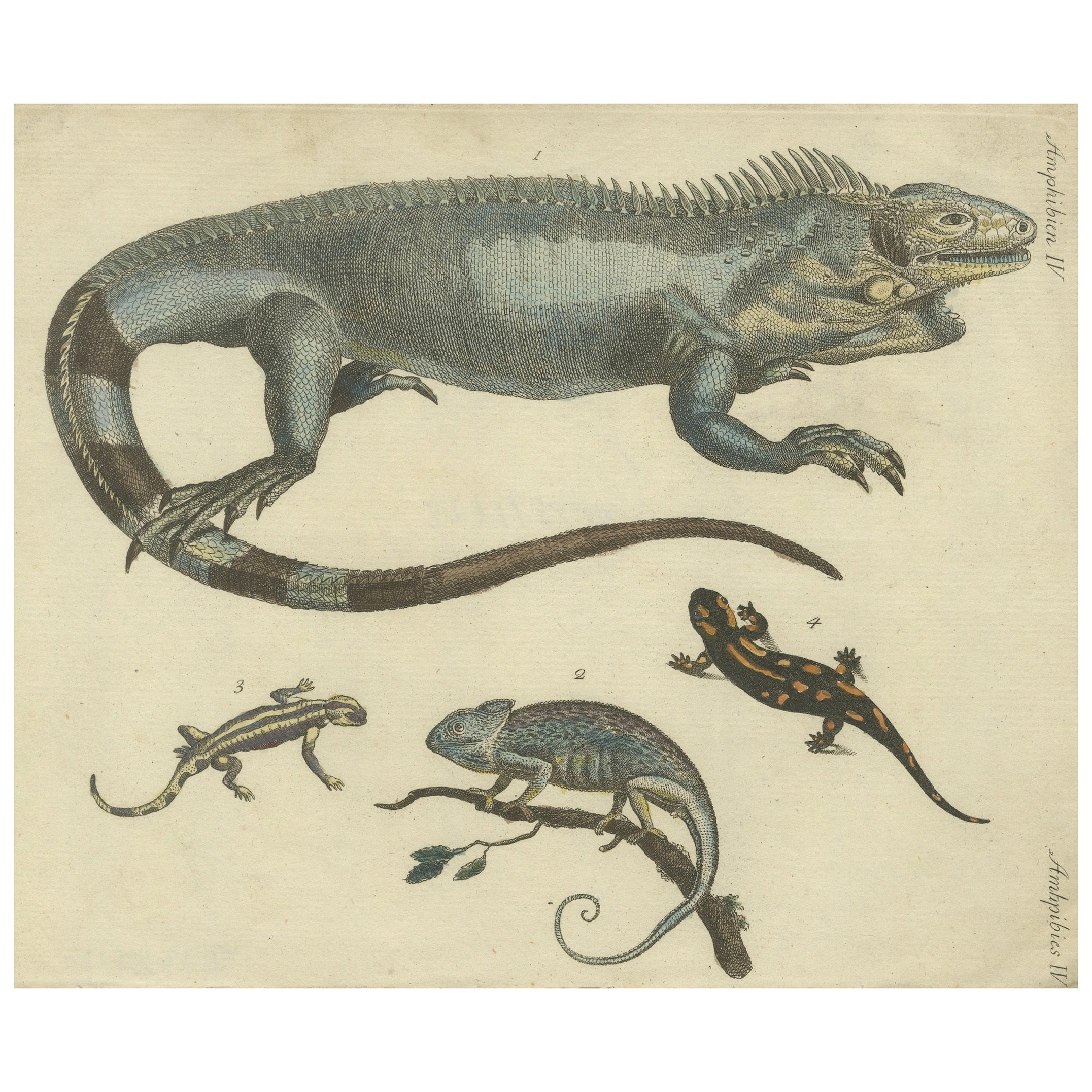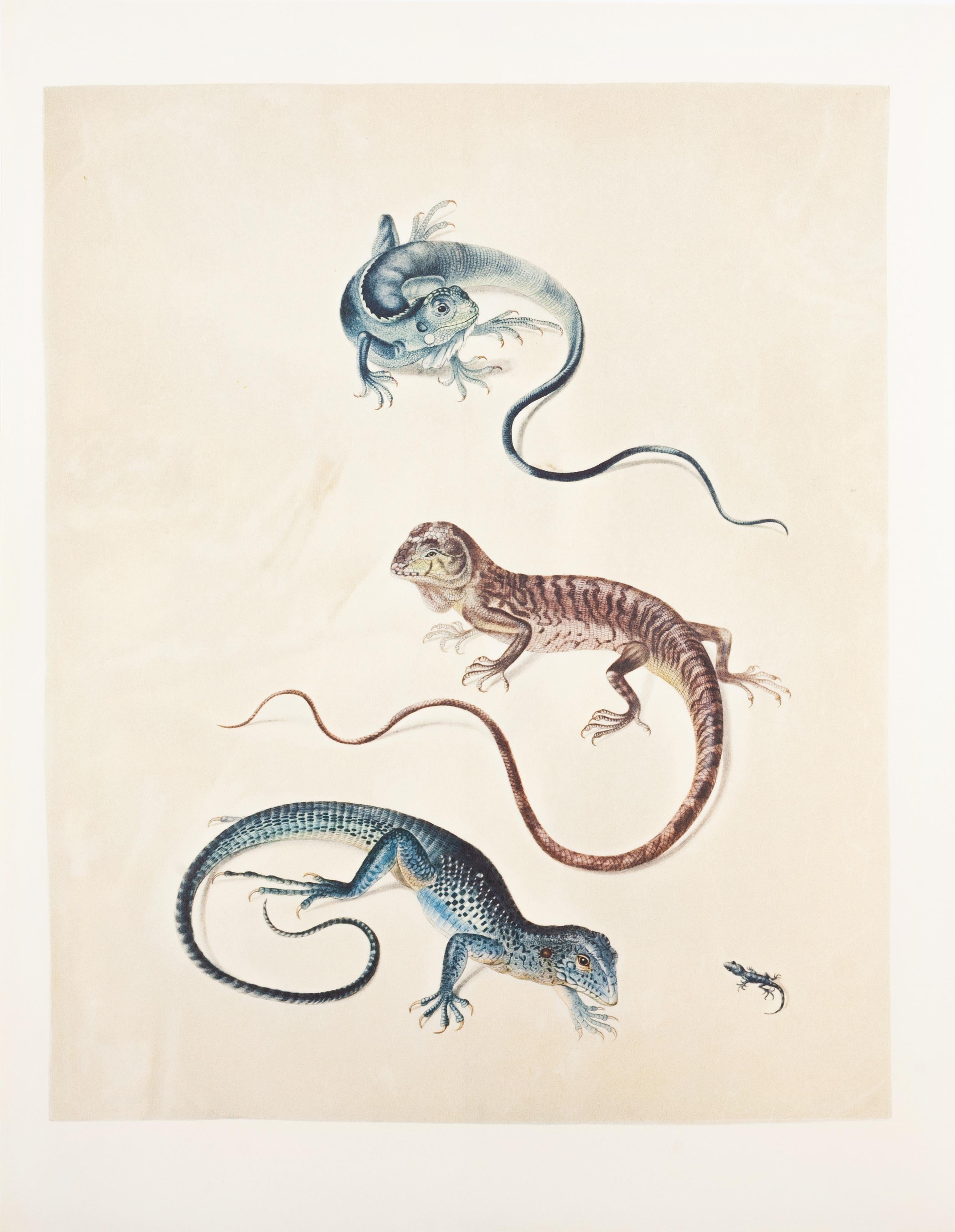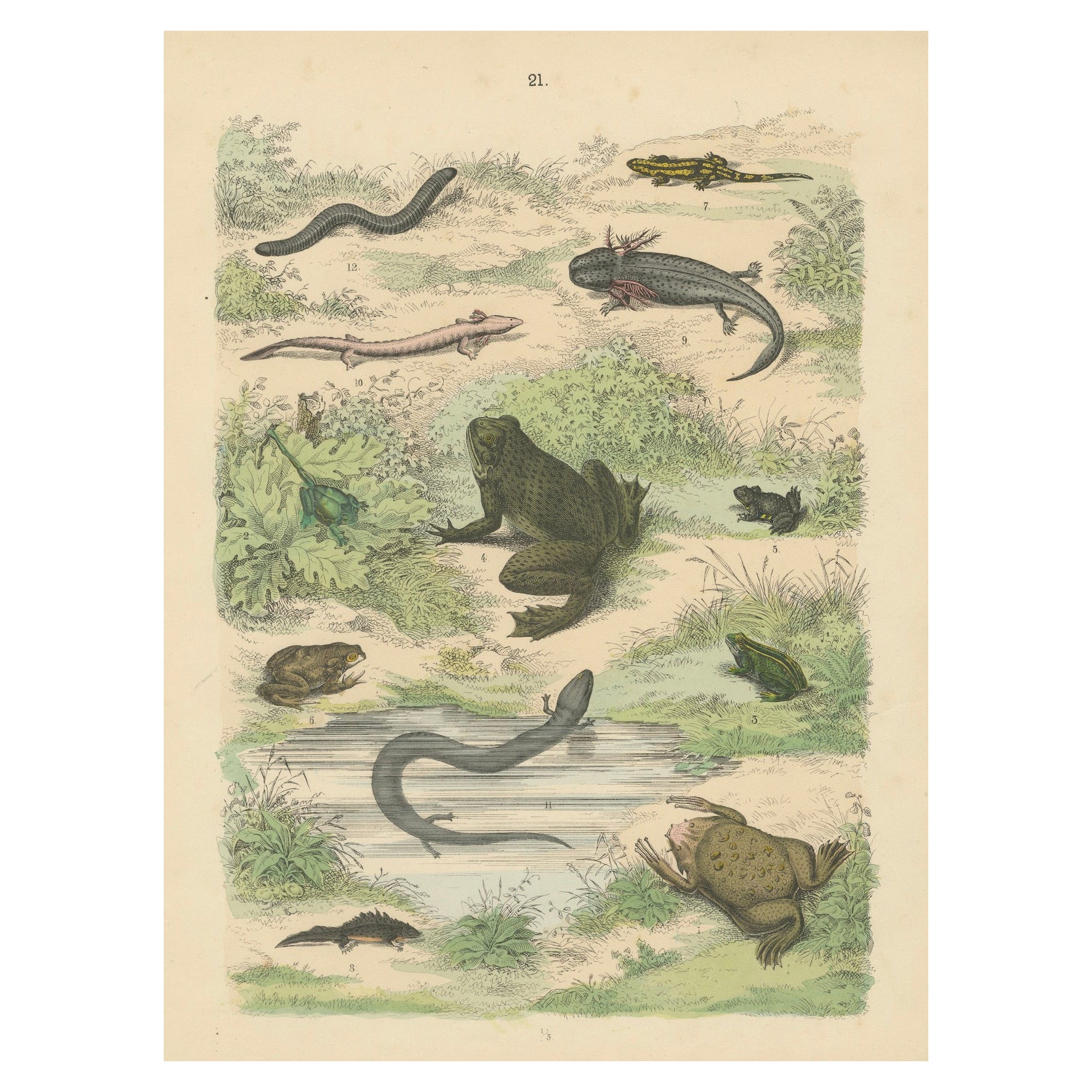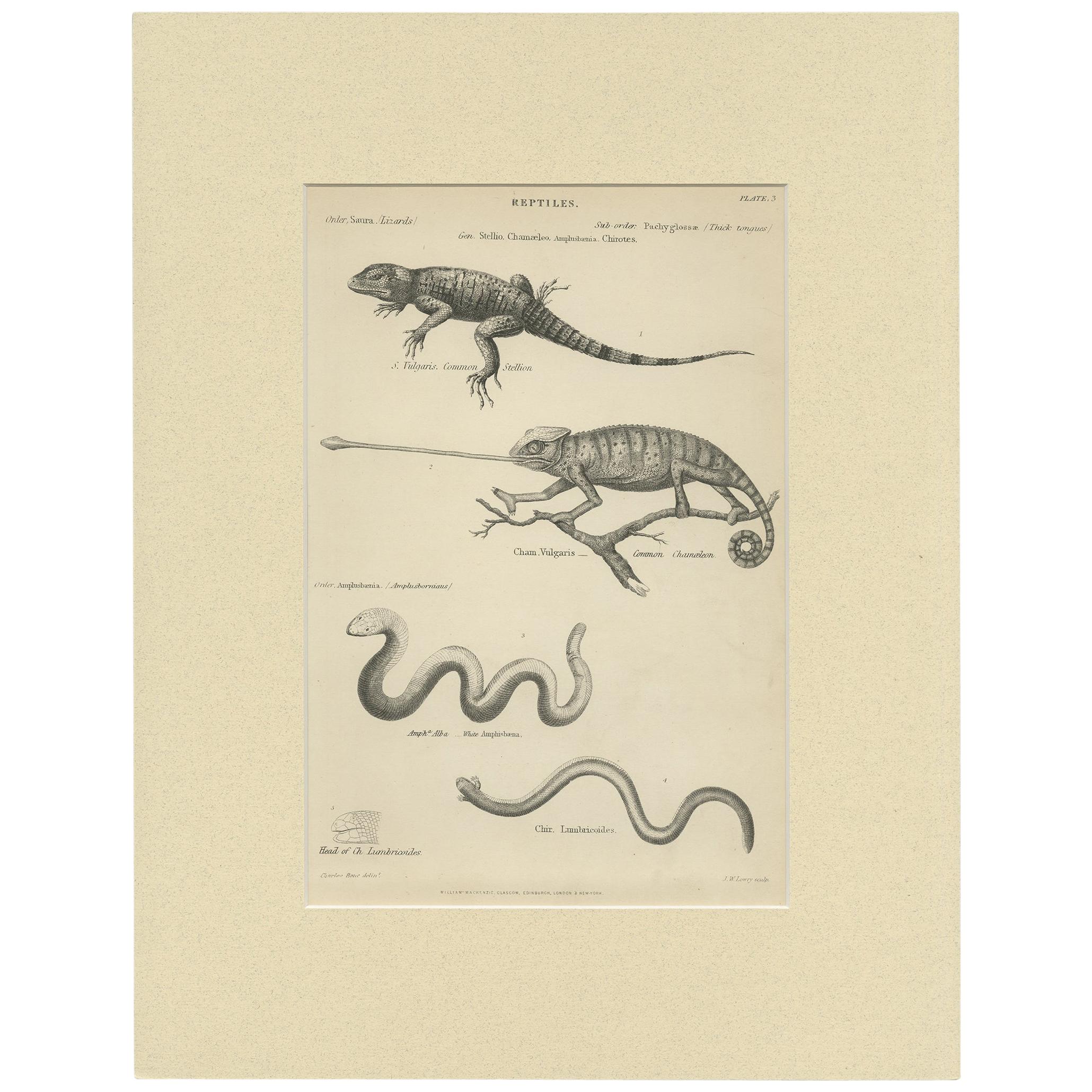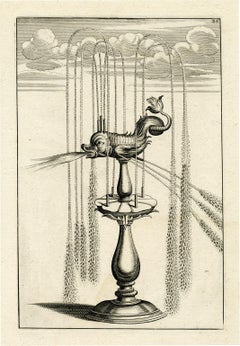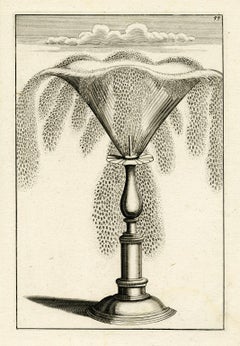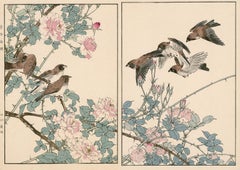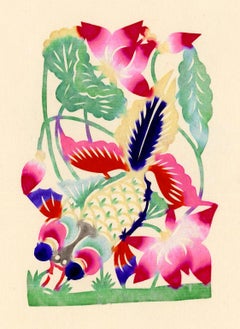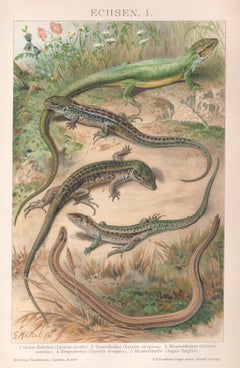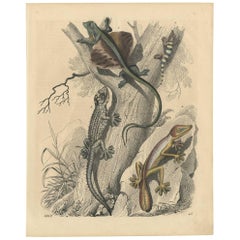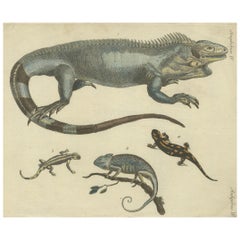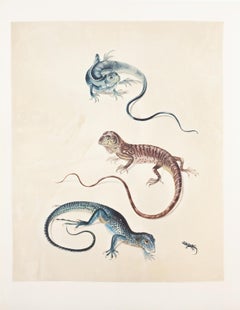Items Similar to Art Forms in Nature (Plate 79 - Basiliscus) — 1899 Celebration of Nature
Want more images or videos?
Request additional images or videos from the seller
1 of 3
Ernst HaeckelArt Forms in Nature (Plate 79 - Basiliscus) — 1899 Celebration of Nature1899
1899
$225
£169.80
€194.40
CA$317.32
A$348.38
CHF 181.75
MX$4,215.92
NOK 2,277.98
SEK 2,146.46
DKK 1,451.12
About the Item
Ernst Haeckel, 'Art Forms in Nature' (Plate 79 - Basiliscus), offset lithograph, 1899. Signed and titled in typeset, upper left. Titled 'Tafel 79 — Basiliscus', upper right and 'Lacertilia. — Eidechsen', bottom center. Lithographic plate rendered and printed by master lithographer Adolf Giltsch, from the original 1899 publication, the full sheet, in excellent condition. Archivally sleeved, unmatted.
Image size 10 15/16 x 7 7/8 inches; sheet size 14 1/4 x 10 11/16 inches.
ABOUT THE IMAGE
Basiliscus is a genus of large corytophanid lizards, commonly known as basilisks, endemic to southern Mexico, Central America, and northern South America. The genus contains four species, commonly known as the Jesus Christ lizard, or simply the Jesus lizard, due to their ability to run across water for significant distances before sinking.
ABOUT THE ARTIST
Ernst Heinrich Philipp August Haeckel, (1834 – 1919) was a German zoologist, naturalist, eugenicist, philosopher, physician, professor, marine biologist and artist. He discovered, described and named thousands of new species, mapped a genealogical tree relating all life forms and coined many terms in biology, including ecology, phylum, phylogeny, and Protista. Haeckel promoted and popularised Charles Darwin's work in Germany and developed the influential but no longer widely held recapitulation theory ("ontogeny recapitulates phylogeny") claiming that an individual organism's biological development, or ontogeny, parallels and summarises its species' evolutionary development, or phylogeny.
The published artwork of Haeckel includes over 100 detailed, multi-colour illustrations of animals and sea creatures, collected in his Kunstformen der Natur, (”Art Forms of Nature”), a book which would go on to influence the Art Nouveau artistic movement. As a philosopher, Ernst Haeckel wrote Die Welträthsel (1895–1899; in English: The Riddle of the Universe, 1901), the genesis for the term "world riddle" (Welträtsel); and Freedom in Science and Teaching to support teaching evolution.
- Creator:Ernst Haeckel (1834 - 1919)
- Creation Year:1899
- Dimensions:Height: 10.94 in (27.79 cm)Width: 7.88 in (20.02 cm)
- Medium:
- Movement & Style:
- Period:
- Condition:
- Gallery Location:Myrtle Beach, SC
- Reference Number:Seller: 1039661stDibs: LU53237583092
About the Seller
5.0
Recognized Seller
These prestigious sellers are industry leaders and represent the highest echelon for item quality and design.
Platinum Seller
Premium sellers with a 4.7+ rating and 24-hour response times
Established in 1995
1stDibs seller since 2016
321 sales on 1stDibs
Typical response time: 1 hour
Associations
International Fine Print Dealers Association
- ShippingRetrieving quote...Shipping from: Myrtle Beach, SC
- Return Policy
Authenticity Guarantee
In the unlikely event there’s an issue with an item’s authenticity, contact us within 1 year for a full refund. DetailsMoney-Back Guarantee
If your item is not as described, is damaged in transit, or does not arrive, contact us within 7 days for a full refund. Details24-Hour Cancellation
You have a 24-hour grace period in which to reconsider your purchase, with no questions asked.Vetted Professional Sellers
Our world-class sellers must adhere to strict standards for service and quality, maintaining the integrity of our listings.Price-Match Guarantee
If you find that a seller listed the same item for a lower price elsewhere, we’ll match it.Trusted Global Delivery
Our best-in-class carrier network provides specialized shipping options worldwide, including custom delivery.More From This Seller
View AllArchitectura Curiosa Nova, Dragon Fish Garden Fountain
By Georg Andreas Böckler
Located in Myrtle Beach, SC
George Andreas Böckler, 'Dragon Fish Garden Fountain', antique copperplate engraving, 1664, from the book 'Architectura Curiosa Nova'. A fine, richly in...
Category
1660s Realist Figurative Prints
Materials
Engraving
Architectura Curiosa Nova, Chalice Garden Fountain
By Georg Andreas Böckler
Located in Myrtle Beach, SC
George Andreas Böckler, 'Chalice Garden Fountain', antique copperplate engraving, 1664, from the book 'Architectura Curiosa Nova'. A fine, richly inked ...
Category
1660s Realist Figurative Prints
Materials
Engraving
Cabbage Rose and Spotted Munia— 19th century woodblock print
Located in Myrtle Beach, SC
Imao Keinen, 'Cabbage Rose and Spotted Munia' from the series 'Birds and Flowers of the Four Seasons', color woodblock Oban diptych, 1882. A fine impression, with fresh colors, on cream Japan paper, in excellent condition. Archivally sleeved, unmatted.
Image size: diptych 12 5/8 x 17 7/8 inches (321 x 452 mm).
ABOUT THE ARTIST
Born in Kyoto, Imao Keinen (1845-1924) studied painting and calligraphy with Umegata Tokyo and Suzuki Hyakunen. He taught at the Kyoto Prefecture School of Painting and exhibited in shows in Japan and Paris. One of the most well-known Japanese painters of his time, Keinen was honored by his country with the title of 'Artist of the Japanese Empire...
Category
1880s Naturalistic Figurative Prints
Materials
Woodcut
$440 Sale Price
20% Off
Fish & Underwater Flowers 2 — Hopei Folk Art, 1950s Chinese Cut Paper Watercolor
Located in Myrtle Beach, SC
'Fish & Flowers', Chinese Hopei Folk Art, 1956. Paper-cut with watercolor, mounted on cream, wove backing paper, with fresh, vivid colors, in excellent condition. Matted to museum standards, unframed.
Image size 3 3/4 x 2 1/2 inches; sheet size 8 7/8 x 6 1/4 inches; mat size 13 x 10 inches.
ABOUT THIS WORK
Hopei or Hebei is a province of North East China, on the Gulf of Chihli near Beijing that is home to Chengde Mountain Resort, the imperial summer residence of the Qing-dynasty emperors. Chengde contains 18th-century palaces, gardens, and pagodas ringed...
Category
Mid-20th Century Folk Art Figurative Drawings and Watercolors
Materials
Watercolor
'Le Paradis Terrestre' (Paradise on Earth) — French Symbolism
By Edouard Goerg
Located in Myrtle Beach, SC
Edouard Goerg, 'Le Paradis Terrestre' (Paradise on Earth), etching, 1931, edition 40. Signed, titled, and numbered '3/40' in pencil. A fine richly-inked impression, on heavy, cream w...
Category
1930s Symbolist Figurative Prints
Materials
Etching
Architectura Curiosa Nova, Sunburst Garden Fountain
By Georg Andreas Böckler
Located in Myrtle Beach, SC
George Andreas Böckler, 'SunBurst Garden Fountain', antique copperplate engraving, 1664, from the book 'Architectura Curiosa Nova'. A fine, richly inked...
Category
1660s Realist Figurative Prints
Materials
Engraving
You May Also Like
Lizards, antique natural history reptile chromolithograph print, circa 1895
Located in Melbourne, Victoria
'Echsen I'
Lizards - chromolithograph from a German natural history series.
Key to lizards below the image.
Gustav Mutzel was a German artist famous ...
Category
Late 19th Century Victorian Animal Prints
Materials
Lithograph
Antique Animal Print of various Amphibians by C. Hoffmann, 1847
Located in Langweer, NL
This print originates from ‘Das Buch der Welt‘ by Carl Hoffmann. Published in Stuttgart, 1847. Lithographs by Engelhorn and Hochdanz.
Category
Antique Mid-19th Century Prints
Materials
Paper
$96 Sale Price
20% Off
Antique Handcolored Engraving of Lizards, Iguana, Chameleon and Salamander, 1800
Located in Langweer, NL
Antique Handcolored Engraving of Lizards, Iguana, Chameleon, and Salamander, Amphibien IV, c.1800
Description: This original handcolored copperplate engraving features four specie...
Category
Antique Early 1800s Prints
Materials
Paper
$231 Sale Price
20% Off
31. Keel-tail iguana, Holbrookia spec., Surinam ameiva, Gecko
By Maria Sibylla Merian
Located in Columbia, MO
Maria Sibylla Merian was born in Germany in 1647 and received early artistic training from her stepfather, an established still life painter. She was fascinated by insects and collec...
Category
18th Century Realist Prints and Multiples
Materials
Pigment
Amphibians Print: Frogs, Salamanders, Axolotl & Caecilian – Antique 1867
Located in Langweer, NL
Amphibians Print: Frogs, Salamanders, Axolotl & Caecilian – Antique 1867
This fascinating antique print depicts a variety of amphibians, including frogs, toads, salamanders, newts, ...
Category
Antique 1860s German Prints
Materials
Paper
Pl. 3 Antique Print of Various Reptiles by Richardson, circa 1860
Located in Langweer, NL
Antique print titled 'Reptiles'. Print of various reptiles (lizards) including the chameleon. This print originates from 'The Museum of Natural History' by John Richardson. Published...
Category
Antique Mid-19th Century Prints
Materials
Paper
$144 Sale Price
20% Off
More Ways To Browse
Form Of A Book
Antique Tafel
Antique Typeset
Hobbs Modern
Hodaya Louis
Ibrahim Kodra On Sale
Innocent Nude
Istvan Orosz
Jacques LaLande On Sale
James Gillray On Sale
Jamie Wyeth Signed Prints
Jamie Wyeth Signed
Jean Carlu 1937
Jean Michel Basquiat Flexible
Jennifer Mack Watkins
Jerry Garcia Signed
John Baldessari Nose Prints
John Hampton Bronze
